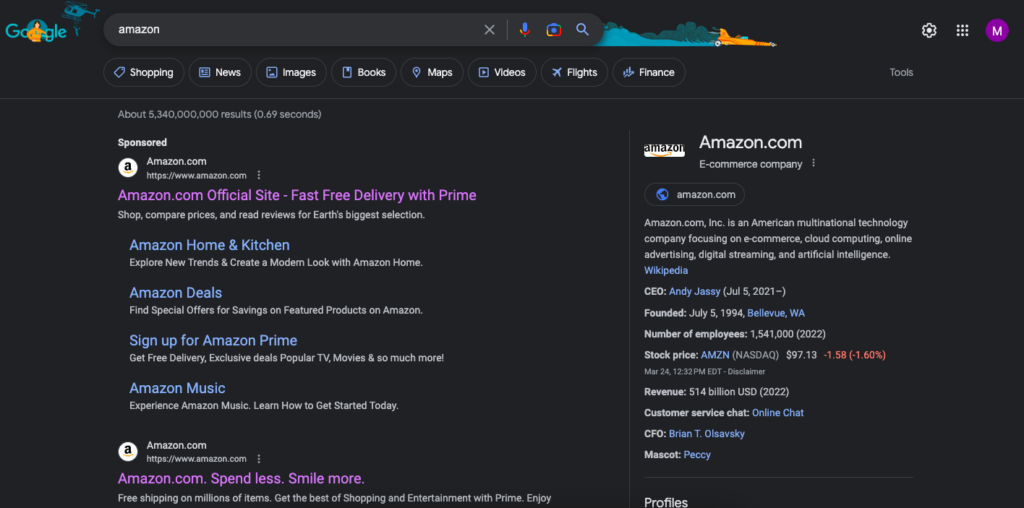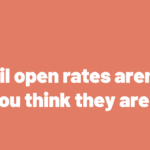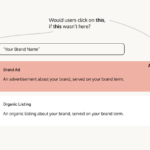Knowing whether brand search is incremental for your brand or not is often a question worth tens of thousands, hundreds of thousands, or millions of dollars. It directly impacts your overall marketing strategy and your budget allocation.
The answer to that question is often brand-specific and we can’t tell you whether it is incremental for you or not. What we can share with you is why it could be and why it could not be and, more importantly, how you can test for it and the experiments you can run to know with more certainty.
What is brand search:
Before we jump in, let’s quickly establish what brand search is: bidding on your brand’s keywords in paid search advertising platforms, like Google Ads or Bing Ads. After a user inputs a query, SERPs (Search Engine Result Pages) will return a combination of organic and paid results.
While the organic results are ranked through SEO, paid results are offered for bidding and ranked through a variety of factors: the bid amount, the quality of the page folks are taken to when they click your ad, the quality of the ad itself, and the relevance to the search.
You can see an example on the image below of Amazon bidding for their own brand name. Their homepage is the first organic result, and they are buying the first paid result as well.

Now, let’s see if brand search is a good allocation of your budget or not:
What Can Make Brand Search Not Incremental?
Empirical evidence supporting the effectiveness of brand search varies, with some marketers observing positive results while others questioning the incremental lift of brand search campaigns.
When it’s not driving a meaningful impact, it’s usually because of these reasons:
a) Attribution Challenges:
Accurately measuring the incremental lift of brand search can be difficult. Google Ads and Google analytics are designed with attribution models that overcredit brand – they’re incentivized to do so so you spend more with them. But marketers that don’t know about incrementality have no idea what’s actually happening.
If you look at your channel’s KPI, brand search might be your most effective channel. Last-click attribution and Google will give it the totality of the credit. However, these are visitors already looking for your brand so the credit should be mostly assigned to the initiatives that drove that search. This can lead to skewed ROI calculations and misinformed budget allocation decisions.
b) Cannibalization of Organic Traffic:
Brand search can potentially have negative effects on organic search traffic if it diverts clicks that would have otherwise gone to organic listings. To minimize this risk, marketers should strategically target and craft messaging that complements their organic search campaigns.
For example, Procter & Gamble (P&G) conducted an experiment in which they significantly reduced their brand search spending and saw no change in business outcomes.
c) Negative Impact on the Overall Marketing Mix:
Allocating your budget effectively is hard to do when your data is skewed and there’s misalignment on what channels you’re giving credit to versus what channels actually drove the actions. If your paid brand search is not incremental, your opportunity cost of not reallocating that budget to more incremental channels can be very high.
What Can Make Brand Search Incremental?
Now, why would anyone bid on brand search then? There are four main reasons why it can be incremental for you:
a) Protection of Brand Positioning:
If a competitor is bidding on your brand term, they might steal some of your best customers – the ones that were already looking for you. Brand search can defend your terms against competitors and help preserve your brand equity by making sure your brand remains visible and dominant for your brand-related queries.
b) Message and Destination Control:
Brand ads give you more control over the message and destination. You can change the copy of your brand ad in an instant and A/B test different messages, which you can’t do with organic search. You can also direct visitors to specific landing pages beyond your homepage since that is usually your first result.
c) Cost-effectiveness and Traffic Volume:
Brand search campaigns typically have a lower cost per click (CPC) and higher return on ad spend (ROAS) compared to non-brand search campaigns. This makes them an attractive option for marketers looking to drive traffic and conversions at a relatively low cost. According to a study by Google which, to be clear, is Google telling you to spend more on Google, brand search ads can increase website clicks by an average of 89%, indicating a positive impact on website traffic volume.
Measuring the Incrementality of Brand Search
Measuring the incrementality of brand search is crucial for understanding its true value and making informed budget allocation decisions. Here, we provide a comprehensive analysis of the key aspects involved in assessing the incremental lift of brand search campaigns.
a) Limitations of Last-Click Attribution Models:
Traditional last-click attribution models assign credit for a conversion to the last touchpoint before the conversion occurred. However, this simplistic approach fails to account for the complex, multi-touch customer journey that often involves multiple channels and touchpoints. Consequently, it can overestimate the impact of brand search on conversions and underestimate the contributions of other channels. To overcome this limitation, marketers should consider employing mixed marketing models that don’t rely on digital tracking.
b) Measuring Brand Search with MMM:
In a perfect world, you could use multi-touch attribution to track every interaction of every customer with your brand. However, with digital tracking being broken and upcoming privacy regulations like ADPPA, marketers need to find ways to better attribute their channels without relying on following people digitally across their entire buying journey.
One great way to solve this and still better understand the true impact of brand search on conversions is Marketing Mix Modeling. In particular, turn-off experiments can be extremely valuable in determining whether brand search is incremental for your brand or not.
Turn-Off Experiments:
In these experiments, marketers temporarily pause their brand search campaigns for a specific group of users (treatment group) while maintaining them for the rest (control group). By comparing the performance of both groups, you can estimate the incremental impact of brand search.
One of the benefits of brand search is that there is often no big lag between the experiment and its outcome – meaning you can tell quickly if it’s incremental or not. If you pause brand search and you don’t see a big decrease in your main KPIs, it’s probably not incremental. If your KPIs plummet, your brand relies on the channel.
eBay, for example, conducted a similar experiment, pausing brand search ads for 30% of their users, and found that the ads did not have a significant impact on sales, prompting a change in their marketing strategy.
d) Factors to Consider When Measuring Incremental Lift:
Several factors can influence the accuracy and reliability of incremental lift measurements::
i. Choice of Control Group:
Make sure you select a control group that is representative and statistically similar to the treatment group. You can use propensity score matching or randomized controlled trials to minimize potential biases. The same size should be large enough to be relevant.
If you don’t want to completely turn off your brand search because you might miss out on sales, there are alternatives to solve for it. You can turn it off on specific geographics, or you can turn it off and on every hour for two weeks and aggregate the results at the end of the experiment. You can only do this with brand search because the time to purchase is usually very short compared to other channels since they googled you in order to buy.
ii. Selection of KPIs:
Choose the right KPIs to measure the impact of brand search campaigns. Revenue, return on ad spend (ROAS), cost per acquisition (CPA) and traffic are often good ones.
iii. Use of Statistical Models:
You will need a robust model to analyze the data from your experiments that can provide reliable estimates of incremental lift, compare against your control group, and give you certainty percentages. We might be able to help you with this at Recast.
Conclusion
So, should you bid on your terms? It depends, some marketers report positive results and others question its incremental lift. There’s only one way to know for sure – and that’s to test and experiment. Don’t rely on last-click attribution and use turn-off experiments to see how incremental it is for your brand specifically. Double down if it is, and consider reallocating your budget if it’s not driving a meaningful impact.



